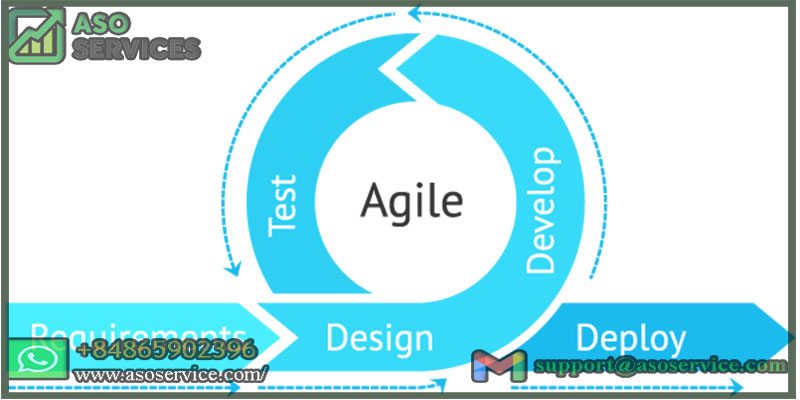Agile Development: Best Practices for Building Successful Software Project
-
07/05/2023
-
1039
-
0
In today's fast-paced software industry, mastering agile development and adopting best practices can make all the difference in building successful software projects.
Related posts
How To Rate An App On Google Play And Apple App Store In 2023
How to increase app reviews and app ratings for Android or iOS apps free
1. Embracing Agile Development Principles
Agile development has become increasingly popular in the software industry as a way to deliver high-quality products that meet customer needs quickly and flexibly. At the heart of agile development are principles that emphasize collaboration, adaptability, and continuous improvement. By embracing these principles, software development teams can overcome common challenges and achieve tremendous project success.
The Agile Manifesto outlines 12 principles that serve as a foundation for agile development. These principles include prioritizing customer satisfaction, delivering working software frequently, and embracing change as a natural part of the development process. By placing the customer's needs at the forefront of development, teams can ensure that they build products that meet real-world needs and deliver value.

Embracing Agile Development Principles, Source: Asoservice.com
Agile development also places a strong emphasis on adaptability and flexibility. Projects are broken down into smaller, manageable chunks, with development occurring in iterative cycles. This approach allows teams to respond quickly to changes in requirements or priorities without derailing the entire project.
One of the most important benefits of embracing agile principles is the focus on continuous improvement. Through regular retrospectives and post-mortems, teams can identify areas for improvement and take steps to address them. This helps to ensure that the team is constantly learning and growing and that the development process is continually optimized for efficiency and effectiveness.
While challenges can be associated with embracing agile principles, such as resistance to change or difficulty in balancing competing priorities, the benefits of adopting this approach can be significant. By prioritizing customer needs, reading Google ratings fostering collaboration and adaptability; and embracing a culture of continuous improvement, software development teams can build successful products that meet the needs of their customers.
2. Establishing Effective Team Processes for Agile Development
Establishing effective team processes is critical for successful agile development. Teams that work together cohesively and efficiently are better equipped to tackle complex software projects and deliver high-quality products promptly. Here are some key factors to consider when establishing effective team processes for agile development:
Iterative Development and Continuous Improvement: Agile development is based on an iterative approach, where development occurs in short cycles or sprints. By breaking the project into smaller, manageable chunks, teams can deliver working software more frequently and respond to changes in requirements quickly. Regular retrospectives and post-mortems are also crucial for identifying areas for improvement and making changes to optimize the development process.
Open Communication and Information Sharing: Agile methodologies like Scrum and Kanban emphasize open communication and information sharing. Regular stand-up meetings or check-ins help team members stay informed about project status and progress and facilitate collaboration and problem-solving. Tools like team chat apps, wikis, and shared documents also promote open communication and help team members stay on the same page.
Agile Project Management Tools: Agile projects management software, such as Jira or Trello, can be incredibly helpful in establishing effective team processes for agile development. These tools provide a centralized location for tracking project progress; assigning tasks, and identifying blockers or issues. They can also help teams stay organized and focused and enable project managers to identify areas for improvement or optimize ASO.
Agile Testing and Quality Assurance Practices: Agile development also emphasizes the importance of testing and quality assurance. By incorporating testing and quality assurance into the development process from the outset, teams can identify and address issues early on before they become more complex and expensive.
By establishing effective team processes for agile development, teams can work together more efficiently and deliver higher-quality products more quickly. With these factors, teams can optimize their development process and deliver successful software projects.
3. Adopting Agile Methodologies
Adopting agile methodologies can be a powerful way to improve the software development process and deliver better results. Agile is an iterative approach to software development that emphasizes collaboration, adaptability, and continuous improvement. Here are some critical steps to consider when adopting agile methodologies:
Choose an Agile Framework: Agile methodologies like Scrum, Kanban, and Lean are popular frameworks for software development. Each has its unique characteristics and can be tailored to fit the needs of your team and project. Consider each framework's strengths and weaknesses and choose one best suited to your needs.
Train Your Team: Agile methodologies require a different approach to software development than traditional methods. It's essential to train your team in the principles and practices of agile development, including iterative development, continuous improvement, and collaborative teamwork.
Set Goals and Objectives: To be successful with agile methodologies, it's essential to set clear goals and objectives for your project. These goals should be specific, measurable, and achievable and should align with the needs of your stakeholders.
Establish Team Processes: Agile development relies on effective team processes, including open communication, regular stand-up meetings, and agile project management tools. Establishing these processes is critical for ensuring your team works together effectively and efficiently.
By following these steps, your team can adopt agile methodologies and improve the software development process. Adopting agile requires a shift in mindset and approach, but the benefits can be significant; including improved collaboration, faster development cycles, and higher-quality products.
4. Implementing Agile Tools and Techniques
Implementing agile tools and techniques is essential for successful software development. Agile is an iterative approach emphasizing flexibility, collaboration, and continuous improvement. Here are some essential tools and techniques to consider when implementing agile methodologies:
Agile Project Management Tools: Agile projects management tools like Jira, Trello, and Asana are popular solutions for managing agile projects. These tools provide a centralized location for tracking project progress, assigning tasks, and identifying issues. They can also help teams stay organized and focused and enable project managers to identify areas for improvement or optimization.
Continuous Integration and Deployment: Continuous integration and deployment are critical techniques for ensuring that software is delivered quickly and highly. These techniques involve automating the build and testing process and deploying changes to production as soon as they are ready.
Pair Programming: Pair programming is a technique where two developers work together at a single workstation. This technique encourages collaboration and knowledge sharing and can help to identify and resolve issues more quickly.
Retrospectives: Retrospectives are regular meetings where team members reflect on the development process and identify areas for improvement. This technique helps teams to improve and optimize their development process continuously.
By implementing these agile tools and techniques, teams can improve collaboration, optimize the development process, and deliver higher-quality software products. Agile methodologies are flexible and can be tailored to the needs of the team and the project. By choosing the right tools and techniques and continuously improving the quantity of app downloads, teams can succeed with agile development.
5. Fostering a Culture of Continuous Learning and Improvement
Fostering a continuous learning and improvement culture is essential for organizations to succeed in today's fast-paced and ever-changing environment. This is especially true in software development, where new technologies and methodologies are constantly emerging. Here are some critical steps to consider when fostering a culture of continuous learning and improvement:
Promote Knowledge Sharing: Encouraging team members to share their knowledge and experiences can help to create a collaborative and supportive environment. This can be achieved through regular team meetings, online forums, or other communication channels.
Conduct Regular Retrospectives: Retrospectives are regular meetings where team members reflect on the development process and identify areas for improvement. Conducting retrospectives helps identify issues and opportunities for improvement and fosters a culture of continuous learning and improvement.
Embrace Experimentation: Encouraging experimentation and risk-taking can help to foster a culture of innovation and continuous improvement. By allowing team members to try new ideas and approaches, organizations can discover new ways of working and drive progress.
By fostering a continuous learning and improvement culture, organizations can improve their agility, competitiveness, and ability to adapt to change. This requires a commitment to ongoing learning and improvement and a willingness to embrace new ideas and approaches. With the right mindset and practices, organizations can create a continuous learning and improvement culture that drives success and growth.
6. Overcoming Common Challenges in Agile Development
Agile development is an iterative approach to software development that emphasizes collaboration, flexibility, and continuous improvement. While agile development offers many benefits, it also presents unique challenges that must be overcome for success. Here are some common challenges in agile development and how to overcome them:
Resistance to Change: One of the most common challenges in agile development is resistance to change. Some team members may be reluctant to adopt new processes, tools, or practices. To overcome this challenge, it's essential to communicate the benefits of agile development, involve team members in the decision-making process, and provide training and support to help them adapt to new ways of working.
Lack of Clarity: Agile development requires a clear understanding of project goals, requirements, and priorities. With clear guidance, team members may be able to prioritize tasks or understand what is expected of them. To overcome this challenge, it's essential to establish clear goals and objectives, communicate requirements and priorities clearly, and involve stakeholders in the development process.
Quality Control: Agile development requires continuous improvement, ensuring the software product meets high-quality standards. To overcome this challenge, it's crucial to establish clear quality metrics, use automated testing tools to catch bugs early, and involve stakeholders in the testing and feedback process.
By understanding these common challenges and implementing strategies to overcome them, organizations can improve their chances of success with agile development. With a commitment to collaboration, communication, and continuous improvement, organizations can leverage the benefits of agile development to deliver high-quality software products that meet the needs of their customers.
Conclusion
In conclusion, mastering agile development through best practices like establishing effective team processes, adopting agile methodologies, implementing agile tools and techniques, and fostering a culture of continuous learning and improvement can help organizations build successful software projects that meet the needs of their customers, adapt to changing market conditions, and drive innovation and growth.
Related posts
https://asoservice.com/increase-app-installs-from-google-ads
https://asoservice.com/google-reviews
Thanks so much for reading this article.
Source: https://asoservice.com/




































Leave a Reply
Your e-mail address will not be published. Required fields are marked *